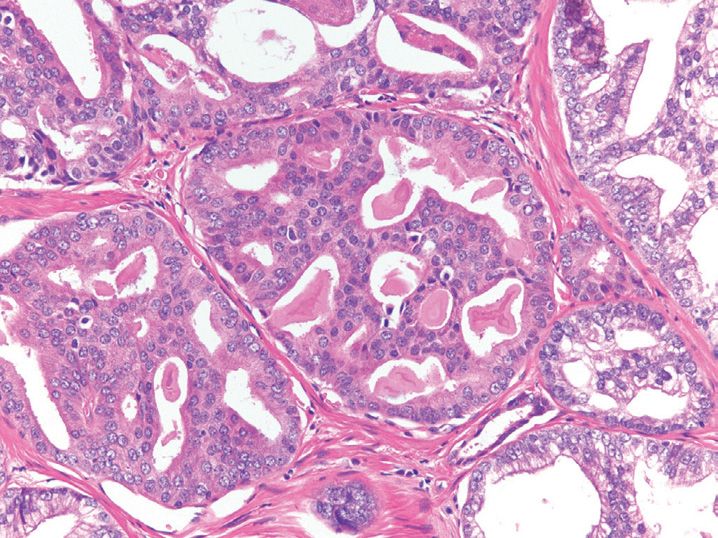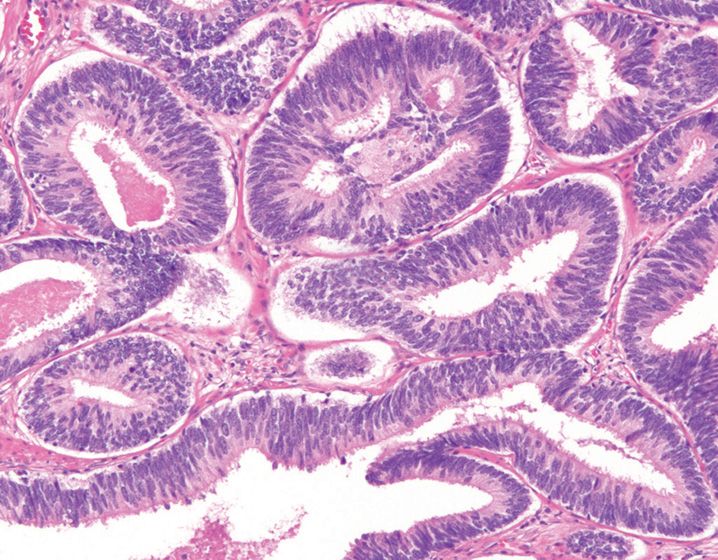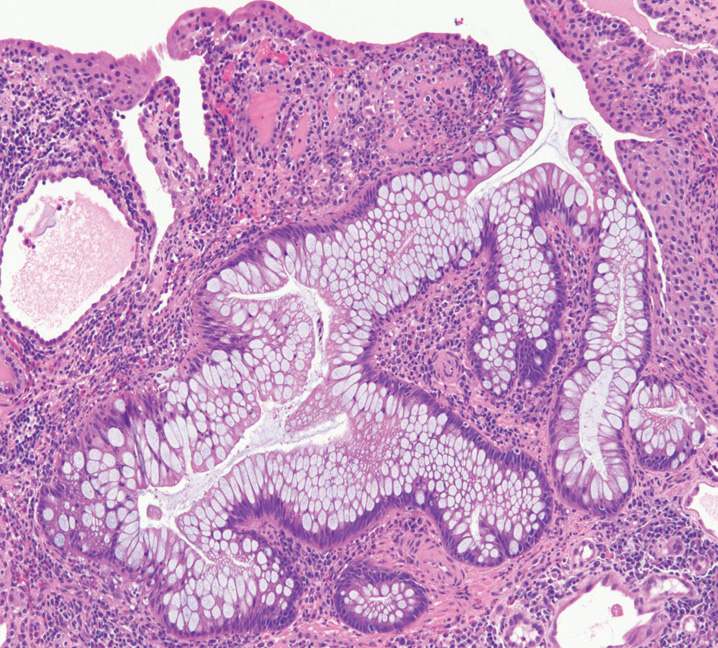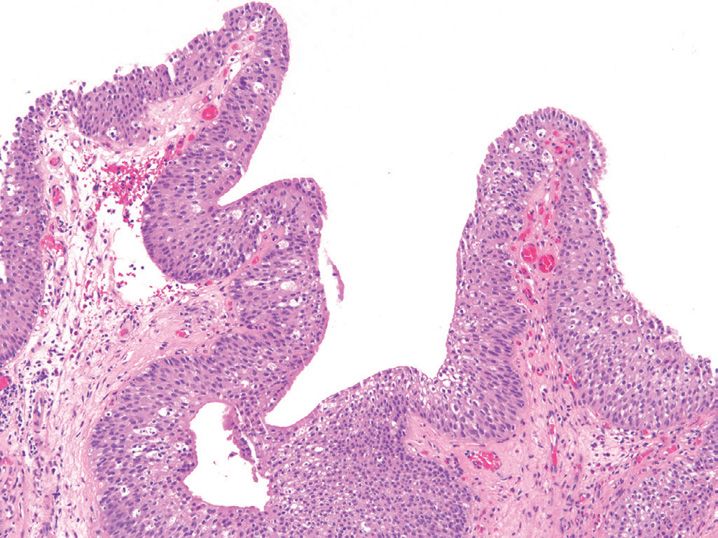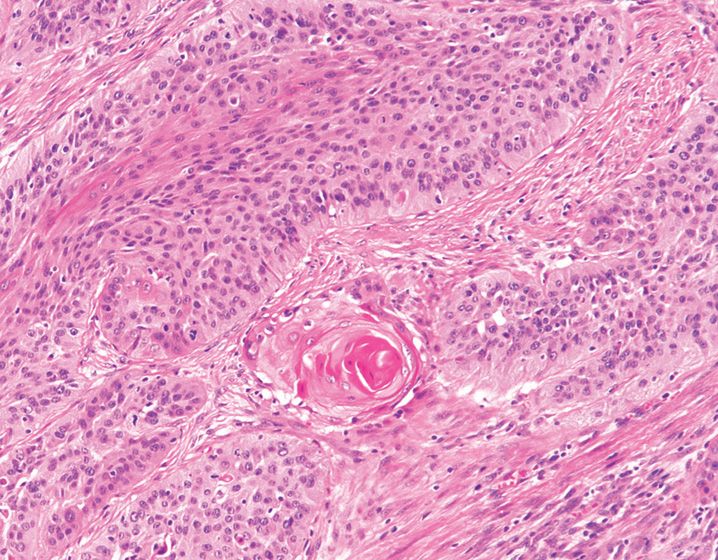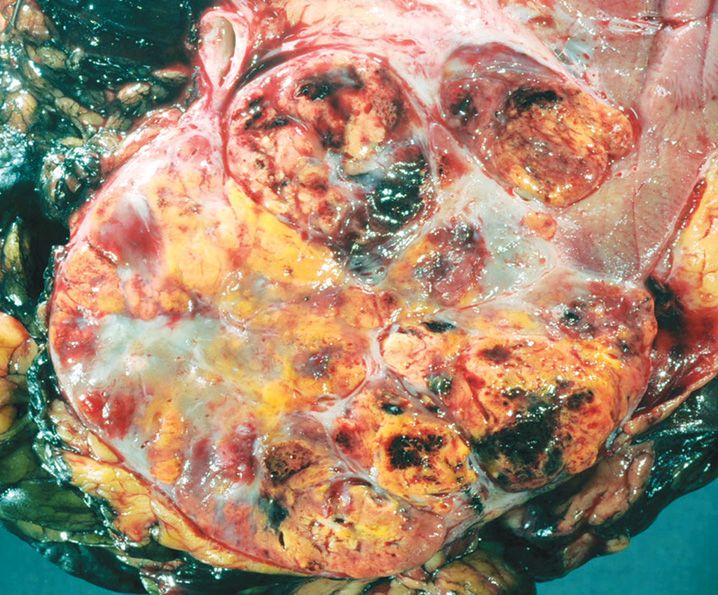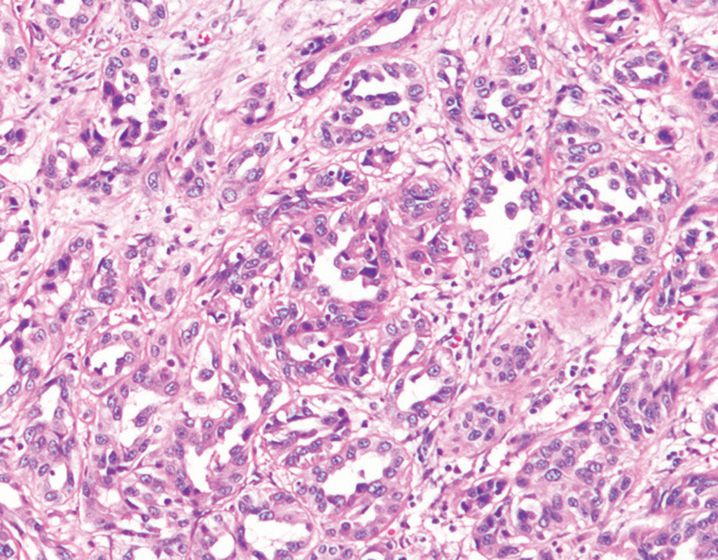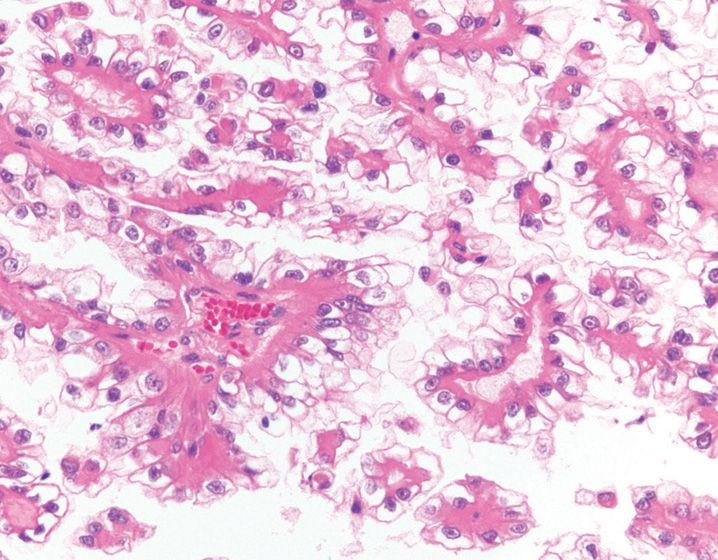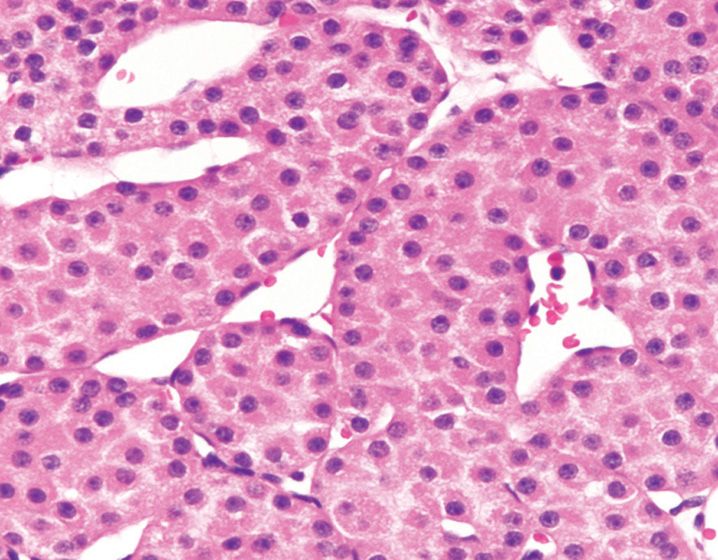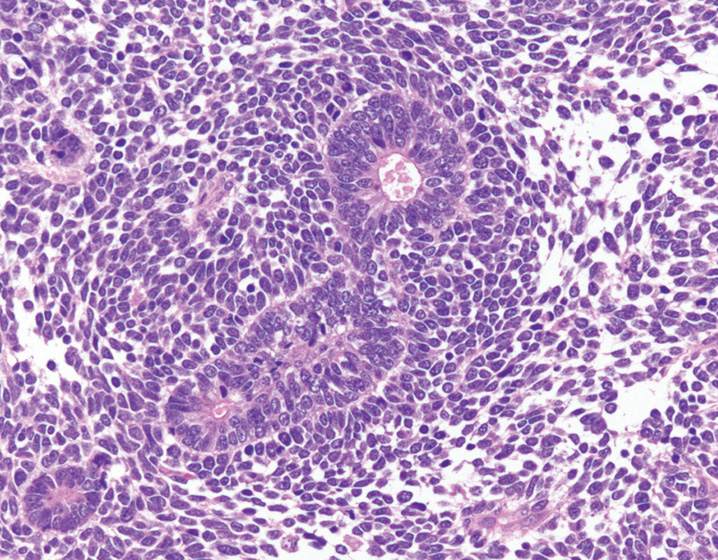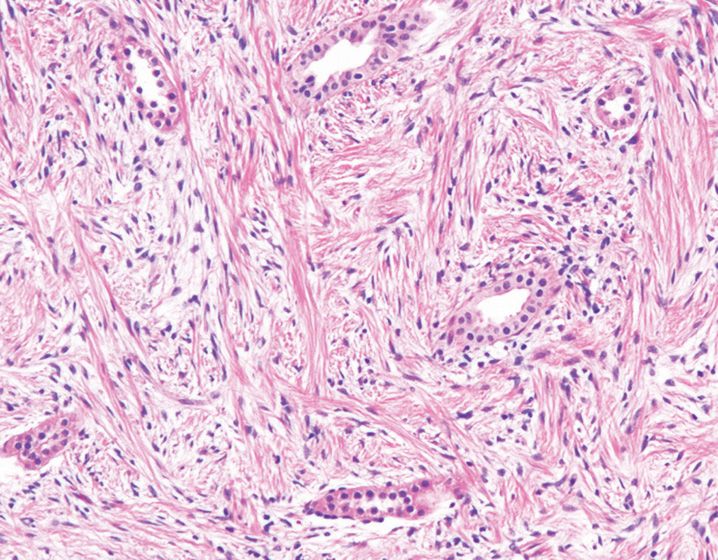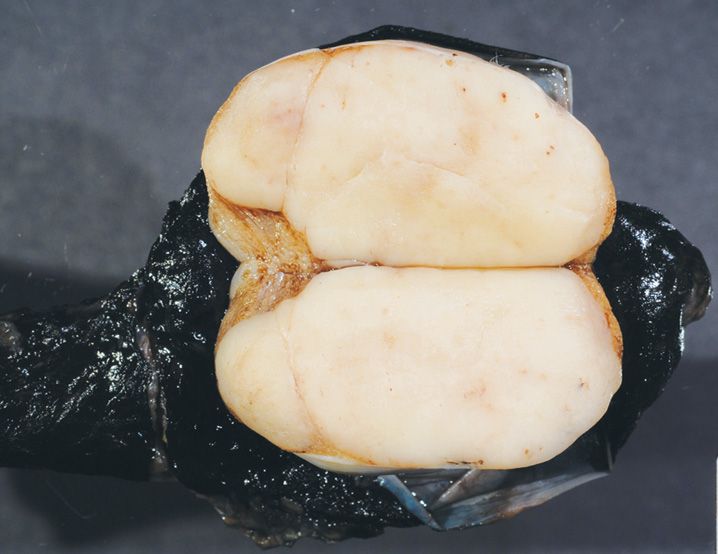FIGURE 14-1
(A) Associated with radiation, stones, and renal transplantation
(B) Lacks AMACR expression
(C) Most commonly found in bladder and prostatic urethra
(D) Often an incidental lesion
(E) Tubules are surrounded by a thickened hyaline sheath
5. Which of the following histologic features is considered to be cancer-specific and has not been described in benign glands?
(A) Collagenous micronodules
(B) Haphazard glandular arrangement
(C) Intraluminal crystalloids
(D) Nuclear hyperchromasia
(E) Small glands with straight luminal borders
6. How would you classify the Gleason pattern of prostatic adenocarcinoma shown in Figure 14-2?
(A) Pattern 1
(B) Pattern 2
(C) Pattern 3
(D) Pattern 4
(E) Pattern 5
7. On an average, how long does it take for prostatic adenocarcinoma to show complete therapeutic response to radiation therapy?
(A) 6 months
(B) 10 months
(C) 12 months
(D) 24 months
(E) 30 months
8. Androgen deprivation causes all of the following changes in benign prostatic tissue, except
(A) Cytoplasmic clearing
(B) Glandular atrophy
(C) Loss of basal cells
(D) Nuclear pyknosis
(E) Stromal predominance
9. A 64-year-old man undergoes prostate biopsy, which is shown in Figure 14-3. Which of the following statements does not apply to this finding?
(A) Better prognosis than acinar carcinoma
(B) In its pure form, it comprises <2% of all prostate cancers
(C) Histology is equivalent of Gleason pattern 4
(D) Presenting symptoms include hematuria and urinary obstruction
(E) Variable cytologic atypia
10. Which of the listed histologic patterns is least likely to be associated with prostatic stromal proliferation of uncertain malignant potential (STUMP)?
(A) Cytologic atypia and necrosis
(B) Hypercellular stroma with atypical cells and normal glandular elements
(C) Hypercellular stroma without atypical cells and normal glandular elements
(D) Hypercellular stroma without glandular elements
(E) Phylloides-like pattern
11. Which of the following compartments comprise majority of the prostatic parenchymal volume?
(A) Anterior fibromuscular stroma
(B) Central zone
(C) Peripheral zone
(D) Periurethral tissue
(E) Transitional zone
12. A 60-year-old man was noted to have irregular nodular elevations of the bladder mucosa. The findings present in his bladder biopsy (see Figure 14-4) are diagnostic of
(A) Adenocarcinoma
(B) Cystitis glandularis
(C) Inverted papilloma
(D) Nested variant of urothelial carcinoma
(E) Urothelial carcinoma in-situ
13. Which of the following clinicopathologic features is least likely to be associated with interstitial cystitis?
(A) Common in elderly women
(B) Essentially incurable disease
(C) Hematuria and pyuria
(D) Mucosal rupture and submucosal hemorrhage
(E) Mural fibrosis and inflammation
14. Which of the following entities is characterized by deposition of inorganic salts within injured urothelial mucosa due to the action of urea-splitting bacteria?
(A) Emphysematous cystitis
(B) Encrusted cystitis
(C) Eosinophilic cystitis
(D) Interstitial cystitis
(E) Malakoplakia
15. All the following statements regarding assessment of renal sinus invasion in a case of clear cell renal cell carcinoma are true, except
(A) The renal sinus is the central fatty compartment that invests the collecting system and abuts the cortical columns of Bertin without a connective tissue interface
(B) Invasion of the renal sinus is staged as pT1
(C) Renal sinus invasion is associated with a poor prognosis
(D) Intravenous extension is the first step in extra-renal spread of clear cell renal cell carcinoma
(E) Most nodules within the renal sinus represent venous involvement
16. Which of the following injurious agents is associated with hemorrhagic cystitis?
(A) BCG
(B) Cytoxan
(C) Mitomycin C
(D) Radiation
(E) Thiotepa
17. A 5-year-old boy presents with leakage of urine from the umbilicus and recurrent episodes of urinary tract infection. Which of the following anomalies is the likely cause of patient’s clinical symptoms?
(A) Bladder exstrophy
(B) Infected umbilical vessels
(C) Omphalitis
(D) Patent omphalomesenteric duct
(E) Patent urachus/urachal cyst
18. In which of the following locations within the bladder is ectopic prostate tissue most likely to be found?
(A) Anterior wall
(B) Dome
(C) Periurethral
(D) Posterior wall
(E) Trigone
19. What is the best classification for a urothelial lesion that shows normal mucosal thickness with loss of cell polarity, irregular nuclear borders, mild cytologic atypia, and rare mitoses?
(A) Flat urothelial hyperplasia
(B) Normal urothelium
(C) Reactive atypia
(D) Urothelial carcinoma in-situ
(E) Urothelial dysplasia
20. A bladder biopsy from a 56-year-old man is shown in Figure 14-5. This diagnostic entity is characterized by all of the following pathologic features, except
(A) Arborization of papillae
(B) Cytologic findings resembling normal urothelium
(C) Lack of detached-appearing papillae
(D) Thicker than normal urothelium
(E) Undulating papillary folds
21. Which of the following risk factors is least likely to cause bladder cancer?
(A) Alcohol
(B) Aniline dyes
(C) Aromatic amines
(D) Cigarette smoking
(E) Phenacetin
22. Which of the following statements is incorrect regarding staging urothelial tumors?
(A) Invasion into adipose tissue indicates extra-vesical extension and constitutes pT3
(B) Invasion into adjacent organs constitutes pT4
(C) Invasion into muscularis propria constitutes pT2
(D) Invasion into subepithelial connective constitutes pT1
(E) Stage T2-T4 are treated with total cystectomy or cystoprostatectomy
23. A 75-year-old man of Egyptian origin undergoes resection of a bladder tumor (see Figure 14-6). Which of the following risk factors is least likely to be associated with this tumor?
(A) Bladder calculi
(B) Bladder diverticulum
(C) Clonorchis sinensis infection
(D) Non-functioning bladder
(E) Renal transplantation
24. All the following criteria are helpful in classifying a tumor as urachal carcinoma, except
(A) Bulk of the tumor is located within the bladder wall rather than the luminal aspect
(B) Direct extension of another primary adenocarcinoma has been excluded
(C) Presence of an in-situ component
(D) Sharp demarcation between the tumor and normal surface epithelium
(E) Tumor is located in the dome or anterior wall of the bladder
25. Which of the following statements about inflammatory myofibroblastic tumor is incorrect?
(A) All lesions express anaplastic lymphoma kinase (ALK) by immunohistochemistry
(B) Mitotic figures may be present
(C) Neoplastic cells are composed of myofibroblastic cells resembling tissue-culture fibroblasts
(D) Some lesions may arise within months following a transurethral resection procedure
(E) The tumor cells can infiltrate the bladder wall and extend into perivesical adipose tissue
26. Which of the following tumors is the most common bladder tumor encountered in children and adolescents?
(A) Inflammatory myofibroblastic tumor
(B) Leiomyoma
(C) Leiomyosarcoma
(D) Lymphoma
(E) Rhabdomyosarcoma
27. A 40-year-old man with history of hypertension underwent resection of a well-circumscribed 3.0 cm bladder tumor. Based on Figure 14-7, which of the following immunohistochemical markers is not expressed by this lesion?
(A) Chromogranin
(B) Cytokeratin
(C) Neuron-specific enolase
(D) S-100
(E) Synaptophysin
28. In what percentage of patients is metastatic disease the initial mode of presentation in patients with clear cell renal cell carcinoma?
(A) 10%
(B) 20%
(C) 30%
(D) 50%
(E) 60%
29. Which is the most common genetic abnormality encountered in patients with sporadic clear cell renal cell carcinoma?
(A) Deletion of chromosome Y
(B) Deletion of 3p
(C) Mutation of c-met
(D) Trisomy 7
(E) Trisomy 17
30. A nephrectomy specimen from a 50-year-old man with a renal mass is shown in Figure 14-8. Which of the following intracellular contents results in the typical golden-yellow appearance of this tumor?
(A) Glycogen
(B) Hyaline globules
(C) Lipid
(D) Mitochondria
(E) Necrosis
31. Besides stage, which of the following features is considered to be a significant prognostic factor in renal cell carcinoma?
(A) Architectural growth pattern
(B) Hemorrhage
(C) Mitotic activity
(D) Necrosis
(E) Nuclear grade
32. From which part of the renal parenchyma does clear cell renal cell carcinoma arise?
(A) Collecting duct
(B) Distal convoluted tubule
(C) Glomeruli
(D) Loop of Henle
(E) Proximal convoluted tubule
33. Which of the following immunohistochemical markers is least likely to be expressed by clear cell renal cell carcinoma?
(A) CAM5.2
(B) CD10
(C) Epithelial membrane antigen
(D) High molecular weight cytokeratin
(E) Vimentin
34. Which of the following features is helpful in distinguishing multilocular cystic renal cell carcinoma from multilocular renal cyst (cystic nephroma)?
(A) Cells lining the cysts
(B) Cytokeratin immunostain
(C) Gross appearance
(D) Cyst contents
(E) Presence of clear cells within fibrous septae
35. How large should a papillary renal tumor be in order for it to be classified as a carcinoma?
(A) 0.1 cm
(B) 0.2 cm
(C) 0.4 cm
(D) 0.5 cm
(E) 1.0 cm
36. A 45-year-old man was found to have this single, cortical-based tumor with necrosis and hemorrhage (see Figure 14-9). Which of these genetic alterations is not typical for this entity?
(A) Deletion of chromosome 3p
(B) Deletion of chromosome Y
(C) Germline mutation in c-met gene
(D) Trisomy 7
(E) Trisomy 17
37. Which of the following immunohistochemical markers helps in distinguishing clear cell renal cell carcinoma with a pseudopapillary growth pattern from a papillary renal cell carcinoma?
(A) CAM5.2
(B) CEA
(C) CD10
(D) CK7
(E) HMWCK
38. All the following features are characteristic of the tumor shown in Figure 14-10, except
(A) Composed of large pale cells with prominent cell membranes
(B) Sarcomatoid transformation occurs in 5% of cases
(C) Stain diffusely with Hale’s colloidal iron
(D) Ultrastructural studies show abundant rough endoplasmic reticulum
(E) Usually located in the lower pole of the kidney
39. A 65-year-old man is noted to have a firm, tan-white kidney tumor located within the medullary pyramid (see Figure 14-11). What is the best diagnosis for this lesion?
(A) Carcinoma of the collecting ducts of Bellini
(B) Metastatic carcinoma
(C) Papillary renal cell carcinoma
(D) Renal medullary carcinoma
(E) Urothelial carcinoma with glandular features
40. Of the tumors listed below, which of the following tumors occurs almost exclusively in patients with sickle cell hemoglobinopathy/trait?
(A) Clear cell renal cell carcinoma
(B) Chromophobe renal cell carcinoma
(C) Collecting duct carcinoma
(D) Oncocytoma
(E) Renal medullary carcinoma
41. An 11-year-old girl undergoes resection of a renal mass shown in Figure 14-12. Which of the following features is diagnostic of this entity?
(A) Papillary growth pattern
(B) Solitary mass located in the cortex
(C) Tan-yellow cut-surface
(D) Nuclear labeling for TFE3 protein
(E) Young age at presentation
42. A 53-year-old asymptomatic woman is diagnosed with mucinous tubular and spindle cell carcinoma. Which of the following histologic findings is least likely to be associated with this lesion?
(A) Alcian blue reactivity
(B) Common in women
(C) Favorable prognosis
(D) High nuclear grade
(E) Vimentin and EMA positivity
43. Which of the following histologic findings would be unusual for the tumor shown in Figure 14-13?
(A) Cystic degeneration
(B) Frequent mitotic activity
(C) Myxoid change
(D) Scattered nuclear atypia
(E) Solid nests
44. A partial nephrectomy specimen from a 21-year-old man shows a tumor composed of small, tightly packed acini and branching tubules. Which of the following features favors a diagnosis of papillary renal cell carcinoma over metanephric adenoma?
(A) Lack of encapsulation
(B) Lack of nucleoli
(C) Numerous mitotic figures
(D) Sharp interface between tumor and adjacent parenchyma
(E) WT-1 staining
45. Metanephric stromal tumor is characterized by all the following features, except
(A) Angiodysplasia
(B) Cartilaginous foci
(C) Desmin immunoreactivity
(D) Juxtaglomerular cell hyperplasia
(E) Onion-skin arrangement of spindle cells
46. What is the peak age of incidence for the tumor shown in Figure 14-14?
(A) 3 months
(B) 1 year
(C) 2 years
(D) 2–5 years
(E) 6 years
47. Anaplasia in Wilms tumor is associated with all the following characteristics, except
(A) Indicates aggressiveness of the tumor
(B) It is rare in patients younger than 2 years of age
(C) Marked nucleomegaly
(D) Multipolar polypoid mitotic figures
(E) Nuclear hyperchromasia
48. Perilobar nephrogenic rests are identified by all of the following features, except
(A) Composed of blastema and tubular pattern with very little stroma
(B) Ill-defined lesions
(C) May remain dormant
(D) Multiplicity
(E) Peripheral location
49. Which of the following pediatric renal tumors typically presents at a mean age of 36 months, is composed of nests of polygonal and spindle cells with pale, vesicular nuclei, and has a propensity to metastasize to the bone?
(A) Clear cell sarcoma
(B) Congenital mesoblastic nephroma
(C) Cystic nephroma
(D) Nephroblastoma
(E) Neuroblastoma
50. Which of the following genes is inactivated rhabdoid tumor of the kidney?
(A) ALK
(B) c-met
(C) SMARCB1
(D) VHL
(E) WT-1
51. A 3-month-old infant is found to have a renal sinus mass shown in Figure 14-15. What is the best diagnosis?
(A) Clear cell sarcoma
(B) Congenital mesoblastic nephroma
(C) Cystic nephroma
(D) Nephroblastoma
(E) Rhabdoid tumor
52. Which of the following statements does not apply to the renal cortical-based lesion shown in Figure 14-16?
(A) Hemorrhage is one of the major complications
(B) Incidence is similar to renal cell carcinoma
(C) Multifocality and bilaterality are common
(D) Predominantly occurs in males
(E) Surgery is curative
53. Which of the following immunohistochemical markers is not expressed by angiomyolipoma?
(A) Actin
(B) Cytokeratin
(C) Desmin
(D) HMB-45
(E) Melan A
54. In an angiomyolipoma, which of the following features is indicative of malignant behavior?
(A) Epithelioid phenotype
(B) Inferior vena cava invasion
(C) Lymph node metastasis
(D) Pushing borders
(E) Renal vein invasion
55. Which of the following markers is least likely to be expressed by a juxtaglomerular cell tumor?
(A) Actin
(B) CD31
(C) CD34
(D) Desmin
(E) Vimentin
56. Which of the following features is least likely to be associated with this 0.8 cm renal medullary lesion shown in Figure 14-17?
(A) Amyloid deposits
(B) Arises in the renal medullary pyramid
(C) Benign behavior
(D) Hypertension
(E) Incidental lesion
57. Cystic nephroma and mixed epithelial and stromal tumor of the kidney present with overlapping clinical and morphologic features listed below, except
(A) Abnormal renal architecture with remnants of nephrons in fibrous septae
(B) Cysts lined by cuboidal cells with hobnail features
(C) Expansile masses with solid and cystic areas
(D) High incidence in women
(E) Ovarian-like stroma within fibrous septae
58. Which of the following subtypes of penile squamous cell carcinoma is most likely to show evidence of human papilloma virus infection?
(A) Basaloid carcinoma
(B) Conventional keratinizing carcinoma
(C) Papillary carcinoma
(D) Pseudohyperplastic carcinoma
(E) Verrucous carcinoma
59. Penile squamous cell carcinoma most commonly arises from which of the following anatomic locations?
(A) Mucosa of coronal sulcus
(B) Mucosa of foreskin
(C) Mucosa of glans
(D) Skin of foreskin
(E) Skin of shaft
60. The worldwide incidence of penile squamous cell carcinoma is highest in which of the following countries?
(A) Australia
(B) China
(C) France
(D) India
(E) Uganda
61. Which of the following groups of lymph nodes is considered to be the “sentinel” drainage basin for penile squamous cell carcinoma?
(A) Deep inguinal lymph nodes
(B) Iliac lymph nodes
(C) Obturator lymph nodes
(D) Paraaortic lymph nodes
(E) Superficial inguinal lymph nodes
62. Which of the following growth patterns of penile squamous cell carcinoma is associated with a high rate of lymph node metastasis and poor prognosis?
(A) Condylomatous
(B) Superficial spreading
(C) Vertical
(D) Verrucous
(E) Warty
63. All the following features support a diagnosis of verrucous squamous cell carcinoma, except
(A) Locally aggressive behavior
(B) Prominent koilocytotic atypia
(C) Regular, broad-based invasive front
(D) Straight papillae with keratin cysts
(E) Well-differentiated tumor cells
64. All the following features favor a diagnosis of Bowenoid papulosis over Bowen’s disease, except
(A) Association with HPV infection
(B) Involvement of the penile shaft
(C) Scaly, plaque-like appearance
(D) Spontaneous regression
(E) Young age of the patient
65. A 28-year-old man is found to have azoospermia, bilaterally normal testicular size, and active spermatogenesis. Which of the following condition is the most likely explanation for patient’s azoospermia?
(A) Cryptorchidism
(B) Excurrent duct obstruction
(C) Germinal cell aplasia
(D) Klinefelter’s syndrome
(E) Maturation arrest
66. All the following conditions are associated with macroorchidism, except
(A) Carney’s complex
(B) Congenital adrenal hyperplasia
(C) Cryptorchidism
(D) Fragile X syndrome
(E) FSH-secreting pituitary microadenoma
67. Testicular feminization syndrome or androgen insensitivity syndrome is characterized by all the following findings, except
(A) 46, XX karyotype
(B) High risk for development of germ cell tumors
(C) Lack of androgen receptor
(D) Leydig cell hyperplasia and Sertoli cell nodules
(E) Phenotypic female
68. A 10-year-old girl with 46, XY karyotype and ambiguous genitalia is found to have a testis on one side and a contralateral streak gonad. Which of these gonadal developmental disorders best explains these findings?
(A) Complete androgen insensitivity syndrome
(B) Dysgenetic male pseudohermaphroditism
(C) Mixed gonadal dysgenesis
(D) Persistent Müllerian duct syndrome
(E) Pure gonadal dysgenesis
69. Which of these statements about intratubular germ cell neoplasia unspecified (ITGNU) is incorrect?
(A) CD117 may be employed to highlight ITGNU
(B) ITGNU is associated with testicular microlithiasis
(C) ITGNU typically occurs in abnormal testis
(D) 10% of adults with ITGNU will develop clinical germ cell tumor within 7 years
(E) Tubules containing ITGNU show reduced spermatogenesis and thickened tubular membranes
70. An orchiectomy specimen from a 40-year-old man is shown in Figure 14-18. What is the most likely diagnosis?
Stay updated, free articles. Join our Telegram channel

Full access? Get Clinical Tree


